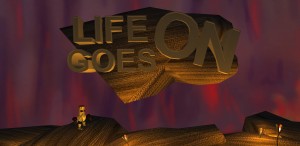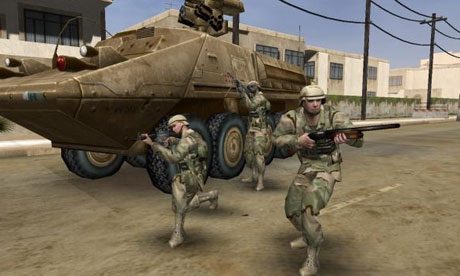The Guardian has a nice short story by Keza MacDonald that asks Are gamers really sexist?. It doesn’t really answer the question or propose solutions, but it documents again how people who speak out against sexist language get harassed.
Category: Computer Games
GRAND 2012 Conference Report
Last week I was at the GRAND 2012 conference. GRAND (Graphics, Animation, and New Media) is a Networks of Centres of Excellence that brings together people across disciplines and across the country around gaming, new media and so on. You can see my GRAND 2012 conference notes here.
This year we had two of the best keynotes of any conference I have been to. Valerie Steeves talked about her research into parents and youth on the internet. The change in attitudes of both parents and youth to the internet between 2000 and today was dramatic. Ken Perlin was the closing keynote and he showed Java apps that he wrote as experiments. It made me want to learn to program in Java just to have as much fun as he was having.
The Art of Video Games at the Smithsonian
Arts Technica has a photo essay on the Smithsonian American Art Museum show The Art of Video Games. The Smithsonian site for the exhibit is here.
From the photographs it looks like they didn’t just do the usual think of showing screen shots and concept art as art, but they have sequences of screens titled “Avances in Mechanics” that show, for example, how jumping has changed in games over time. The exhibit also seems to have a historical bent:
The Art of Video Games is one of the first exhibitions to explore the forty-year evolution of video games as an artistic medium, with a focus on striking visual effects and the creative use of new technologies. It features some of the most influential artists and designers during five eras of game technology, from early pioneers to contemporary designers. The exhibition focuses on the interplay of graphics, technology and storytelling through some of the best games for twenty gaming systems ranging from the Atari VCS to the PlayStation 3. (from the exhibit site)
Digitalkoot
Sinead introduced me to a cool crowdsourcing game from the National Library of Finland called Digitalkoot. As your proof words from the OCRing of 19th century newspapers you create bridges for moles. The YouTube above shows the game. The company behind this will apparently build and run a game like this for you for a fee.
Life Goes On
David, one of the students I work with was involved in a Hackathon and Global Game Jam in Edmonton. The team he was on developed a very cool game idea called, Life Goes On. The idea was to make dying a game mechanic. You can now download the game now and try it.
Are video games just propaganda and training tools for the military? | Technology | The Guardian
The Guardian has a good story on Are video games just propaganda and training tools for the military?. Despite the title, the story doesn’t really take sides. It documents the variety of ways that game companies and armies interact from companies like Kuma Games that make Kuma\War games out of current events. The article also links to an interesting grant award to Kuma from the Department of Defense for game-based second language training:
Utilizing our tools, experience, and huge library of existing 3D assets we can provide an effective, cost-efficient, rapidly-deployable and easily updatable language retention toolset for trainers and Soldiers deployed around the world. It is our intention to refresh languages skills in an intense and immersive 3D environment, which would be made available as part of an online/offline language exercise portal …
The article also documents games made from an Arab perspective by companies in Syria, developers tied to the Hezbollah and Irani organizations. These games (whether the Kuma\War games or those from other perspectives) can be seen as soft propaganda – making normal attitudes about who is good and bad. Such games don’t train people the way simulators might, but they can recruit people or legitimize a cause.
One could argue that just as in the Cold War the “soft power” of American movies played a key role, so in the percieved conflict with terrorism software is playing a similar propaganda role. The problem may be that the wrong people are being portrayed as the bad guys. The propaganda on both sides may be too crude and may make reconciliation harder.
In the meantime Iran has sentenced one of the Kuma designers to death accusing him of developing for the CIA. The game gets serious for this poor designer who was detained when he visited family in Iran.
Interview with doujinshi creator
While I was in Japan I had the good fortune to meet a number of people who were involved in the creation of fan circle or doujin manga, anime and games. These circles and the often very professional fan works they publish are a phenomenon that is important to understanding Japanese popular culture so I asked one if I could interview her about her experience. The interview was conducted over email in December of 2011, January and Februrary of 2012. I sent her questions, she sent back answers, and I edited them into this dialogue which she then checked and added to. In my editing I tried to keep her distinctive voice, but did edit for grammar where confident in her meaning. In some cases I have added explanations that are [in brackets and italicized.] I have kept her identity secret at her request.
More photos added about arcades, pachinko and emulators

I’ve posted some more sets of gaming related photographs on my Flickr account.
- Documentation for emulator test at Ritsumeikan Game Archive Project: I’ve posted photographs of the original consoles and the Nintendo Famicom emulator that I took for an experiment on testing emulators. The Nintendo emulator is the one official emulator around and it was commissioned by Professor Koichi Hosoi.
- Arcade, Pachinko and other sites in Kyoto: I’ve posted a set of photographs I took on a full day excursion with colleagues to an arcade, a Pachinko parlour and to game related stores. This time I played a bunch of the games.
Interview with Professor Uemura
On Friday the 16th, of December I interviewed Masayuki Uemura who is a Professor at Ritsumeikan since 2003, but is also known as the head of the division that designed the Famicom when he was at Nintendo. Professor Mitsuyuki Inaba translated for us as Professor Uemura doesn’t speak English and I don’t speak Japanese. We talked mostly about his current research into patterns of play.
Uemura and his lab have developed a system that captures play activity as subjects play video games. They simultaneously capture:
- Video of the game screen,
- Video of the player with a time and date stamp,
- Information about the number of times different controller buttons are pressed, and
- Video of a system of lights that shows what buttons are being pressed and the elapsed time.
This is combined into a single video with four squares so that they can review subjects playing and simultaneously see what they are doing. The controller buttons being pressed is also recorded as data that they can analyze. I asked if they had thought of capturing the controller data (when buttons are pressed and for how long) as MIDI and he said they tried that, but couldn’t get rid of latency in the capture. They are now experimenting with gathering more data like heart rate, but that is intrusive so they are also thinking of eye-tracking. The idea is to capture as much information about player behaviour as possible so as to compare players and try to understand differences between players. He is trying to see if there are types of players (like button mashers vs careful button pressers.) After they capture a subject playing they follow that up with an interview as he feels that there is a lot more to game playing than what happens on the screen. He would like to capture as much context as possible.
He talked about an interesting phenomenon where players repeatedly press a button that doesn’t do anything (the up in the cross-shaped joypad.) He showed me a slide with results of a test of 7 participants with the amount that they pressed the up button in 8 minute segments. Strangely the players that self-identified as experts pressed up a lot more. He has also been looking at when they press combinations of buttons. At the moment he is still gathering data and he is interested in cross-cultural comparisons of how players in different countries play the same games. He has gathered some data from Chinese players (who generally play pirated versions of games) to see if there are differences between Chinese and Japanese players. We talked about gathering data from Canadian players too.
While he described some of his preliminary findings, he was reluctant to speculate as to why there would be differences or why players would continue using a button that doesn’t do anything. It was clear to me that he wanted to be rigorous in the description of player behaviour and not indulge in speculation about the reasons for differences too early.
At the end of the interview (or I should say discussion) we talked a little bit about Nintendo. He has an article coming out in the journal of DiGRA Japan (Japanese) where he discusses his experiences at Nintendo and the development of the Famicom. He encouraged me to read that when it comes out.
Video games can never be art – Roger Ebert’s Journal
I had, of course, heard that Roger Ebert had made statements to the effect that games can’t be art, but hadn’t bothered to track them down. Here is his sustained argument, Video games can never be art which takes as its foil Kellee Santiago’s TED talk on the subject. One way to read this debate is that it becomes a matter of definition. If you define art in a certain way then yes, games aren’t art, by definition. And Ebert seems to feel that either games can never be art, or it will take so long that we will all be dead by then (which is more or less the same thing.) Santiago, by contrast, argues that one shouldn’t judge the artistry of a genre in its infancy. I will have to think so more on this, but here are some first reactions:
- Ebert’s definition of art from Plato, that it is the” imitation of nature,” does not, to my mind, define games out of the picture. One could respond that games imitate different features of nature like movement, flow, and interactivity. Ebert goes on to argue that art “grows better the more it improves or alters nature through an (sic) passage through what we might call the artist’s soul, or vision.” Again, I don’t think this definition excludes games in principle. What it does is reiterate a Renaissance belief in the vision of a genius, which even Ebert realizes excludes all sorts of art (like cathedrals.) The particular way we interact with games tends to hide the genius of creators – we don’t look on them with wonder at their creation. If caught up in them we play as if we were in the fictional world. Ebert may be right that our relationship with games is not a sacred one of visionary transformation before FINE ART, but that is a questionable and historically constructed relationship. I can imagine a future where games and their designers are treated with such reverence.
- If Ebert is going to draw on Plato and Aristotle he should be open to another sense of art as craft. The painter who imitates nature uses technique to craft a believable representation. That craft or techne is what Plato and Aristotle were interested in, not some sacred relationship through genius. Plato was concerned with the effects of performing the poets (as opposed to listening to them) which is how epics were consumed – they were acted out – and he worried about youth playing disreputable characters. Video games are criticized in very similar ways – that they habituate youth to doing nasty things like killing zombies. Plato wanted to banish the poets and would probably have similar concerns about game designers today. Fine art, however, has been safely neutered so youth don’t really get to do more than wear tights for a Shakespeare play which no one seriously considers dangerous. In that sense games are the inheritors of a craft of imitation and context for player imitation that Plato called art. Art is no longer the art Plato warned us about. Games are now the dangerous imitation of nature. As for Aristotle, he was concerned with the place of craft in a hierarchy of knowledge and games are clearly technical productions that fit the class of crafts.
- Ebert is right at the end to suggest that it shouldn’t matter to players that games are not art just as chess players don’t worry about it being an art. Perhaps we just need to define our terms and create a supercategory of fictions (imaginative things that we make). The fine arts and games are all members of this category. There are better and worse games just as there are better and worse plays. There are serious games that are meant to be high culture and there are potty performances that appeal to the worst in us. We have developed traditions of interpreting, playing and judging both games and fine art.
- Why does it matter that games be an art? I suspect this says more about the maturing of gaming than it does about art. Gamers and game studies want the respect of being high culture for all sorts of reasons from academic acceptance to acceptance as a past-time. We used to treat games as something children played and adults were encouraged to get serious. I was certainly encourage to drop (or hide) my passion for military simulations (war games) when I entered high school and realized there were all sorts of cool women I wanted to talk to (who would laugh at my passion). Things have changed – boy culture or nerd culture is triumphant and it rightly wants to shed the association of its values with adolescence. Where I stopped playing games this generation is unafraid to be openly associated with gaming. The only remaining barrier is the perception that games, while they may be an adult pastime, are not serious art capable of bettering the soul (which is what we tell ourselves that the fine and performing arts do.)
- Which returns us to the question of transformation? Can a game change your mind, influence your imagination, or transform your life the way we think high art can? I would argue that they can, but they do it in a different way than the fine art or philosophy does. Monopoly doesn’t tell you about capitalism or show capitalism at work. It creates a context in which you play as if a certain view of capitalism were true (that acquiring property and bankrupting people is the goal.) If you are changed by Monopoly it is not that you think “Oh, the designer had an interesting view about Monopoly that has changed my mind.” Instead you take on the habits or world view of a monopolist (or someone who is appalled by monopolies). It can change you, but in ways we aren’t trained to talk about the way we can talk about the transformative vision of Michelangelo. With time we will develop the critical traditions and feel just as comfortable asking about the world imitated in a game and its assumptions. Asking if games are art is one way to open this up. One day we will wake up and find there is a canon of what were transformative games. Until then we can play without thinking too much.


